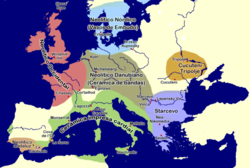Top Qs
Timeline
Chat
Perspective
Starčevo–Körös–Criș culture
Grouping of archaeological cultures From Wikipedia, the free encyclopedia
Remove ads
The Starčevo–Karanovo I-II–Körös culture[1] or Starčevo–Körös–Criș culture[2] is a grouping of two related Neolithic archaeological cultures in Southeastern Europe: the Starčevo culture and the Körös or Criș culture.
Remove ads
Settlements
Some of the earliest settlements of the Starčevo–Körös–Criș culture were discovered in the Banat Plain and southwest Transylvania.[3] Culture sites were also discovered in the north-west Balkans, which yielded painted pottery noted for its "barbotine" vessel surfaces.[4] Specifically, the Starčevo settlements were located in Serbia, Körös in Hungary, and Criș in Romania.[5]
Characteristics
The Starčevo culture is an archaeological culture of Southeastern Europe, in what is now Serbia, dating to the Neolithic period between c. 5500 and 4500 BCE[6] (according to other source, between 6200 and 5200 BCE).[7] The Starčevo culture is sometimes grouped together and sometimes not.[8]
The Körös culture is another Neolithic archaeological culture, but in Central Europe. It was named after the river Körös in eastern Hungary and western Romania, where it is named Criș.[9] It survived from about 5800 to 5300 BC.
Remove ads
Gallery
- Starčevo culture sculpture
- Starčevo culture artefacts
- Körös/Criş culture figurine
- "Red-haired goddess" figurine
- Figurine
- Starčevo ceramic altar
- Reconstruction of a settlement at Tumba Madzari, Macedonia
References
Sources
Further reading
Wikiwand - on
Seamless Wikipedia browsing. On steroids.
Remove ads







